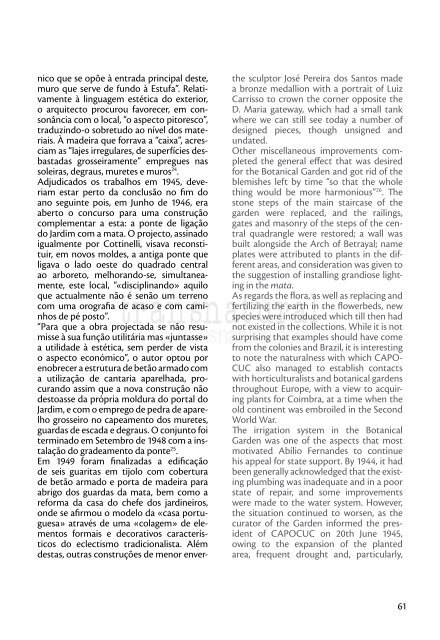Jardim Botânico de Coimbra: contraponto entre a Arte e a ... - artez
Jardim Botânico de Coimbra: contraponto entre a Arte e a ... - artez
Jardim Botânico de Coimbra: contraponto entre a Arte e a ... - artez
You also want an ePaper? Increase the reach of your titles
YUMPU automatically turns print PDFs into web optimized ePapers that Google loves.
nico que se opõe à entrada principal <strong>de</strong>ste,<br />
muro que serve <strong>de</strong> fundo à Estufa”. Relativamente<br />
à linguagem estética do exterior,<br />
o arquitecto procurou favorecer, em consonância<br />
com o local, “o aspecto pitoresco”,<br />
traduzindo-o sobretudo ao nível dos materiais.<br />
À ma<strong>de</strong>ira que forrava a “caixa”, acresciam<br />
as “lajes irregulares, <strong>de</strong> superfícies <strong>de</strong>sbastadas<br />
grosseiramente” empregues nas<br />
soleiras, <strong>de</strong>graus, muretes e muros 24 .<br />
Adjudicados os trabalhos em 1945, <strong>de</strong>veriam<br />
estar perto da conclusão no fim do<br />
ano seguinte pois, em Junho <strong>de</strong> 1946, era<br />
aberto o concurso para uma construção<br />
complementar a esta: a ponte <strong>de</strong> ligação<br />
do <strong>Jardim</strong> com a mata. O projecto, assinado<br />
igualmente por Cottinelli, visava reconstituir,<br />
em novos mol<strong>de</strong>s, a antiga ponte que<br />
ligava o lado oeste do quadrado central<br />
ao arboreto, melhorando-se, simultaneamente,<br />
este local, “«disciplinando» aquilo<br />
que actualmente não é senão um terreno<br />
com uma orografia <strong>de</strong> acaso e com caminhos<br />
<strong>de</strong> pé posto”.<br />
“Para que a obra projectada se não resumisse<br />
à sua função utilitária mas «juntasse»<br />
a utilida<strong>de</strong> à estética, sem per<strong>de</strong>r <strong>de</strong> vista<br />
o aspecto económico”, o autor optou por<br />
enobrecer a estrutura <strong>de</strong> betão armado com<br />
a utilização <strong>de</strong> cantaria aparelhada, procurando<br />
assim que a nova construção não<br />
<strong>de</strong>stoasse da própria moldura do portal do<br />
<strong>Jardim</strong>, e com o emprego <strong>de</strong> pedra <strong>de</strong> aparelho<br />
grosseiro no capeamento dos muretes,<br />
guardas <strong>de</strong> escada e <strong>de</strong>graus. O conjunto foi<br />
terminado em Setembro <strong>de</strong> 1948 com a instalação<br />
do gra<strong>de</strong>amento da ponte 25 .<br />
Em 1949 foram finalizadas a edificação<br />
<strong>de</strong> seis guaritas em tijolo com cobertura<br />
<strong>de</strong> betão armado e porta <strong>de</strong> ma<strong>de</strong>ira para<br />
abrigo dos guardas da mata, bem como a<br />
reforma da casa do chefe dos jardineiros,<br />
on<strong>de</strong> se afirmou o mo<strong>de</strong>lo da «casa portuguesa»<br />
através <strong>de</strong> uma «colagem» <strong>de</strong> elementos<br />
formais e <strong>de</strong>corativos característicos<br />
do eclectismo tradicionalista. Além<br />
<strong>de</strong>stas, outras construções <strong>de</strong> menor enver-<br />
the sculptor José Pereira dos Santos ma<strong>de</strong><br />
a bronze medallion with a portrait of Luiz<br />
Carrisso to crown the corner opposite the<br />
D. Maria gateway, which had a small tank<br />
where we can still see today a number of<br />
<strong>de</strong>signed pieces, though unsigned and<br />
undated.<br />
Other miscellaneous improvements completed<br />
the general effect that was <strong>de</strong>sired<br />
for the Botanical Gar<strong>de</strong>n and got rid of the<br />
blemishes left by time “so that the whole<br />
thing would be more harmonious” 26 . The<br />
stone steps of the main staircase of the<br />
gar<strong>de</strong>n were replaced, and the railings,<br />
gates and masonry of the steps of the central<br />
quadrangle were restored; a wall was<br />
built alongsi<strong>de</strong> the Arch of Betrayal; name<br />
plates were attributed to plants in the different<br />
areas, and consi<strong>de</strong>ration was given to<br />
the suggestion of installing grandiose lighting<br />
in the mata.<br />
As regards the flora, as well as replacing and<br />
fertilizing the earth in the flowerbeds, new<br />
species were introduced which till then had<br />
not existed in the collections. While it is not<br />
surprising that examples should have come<br />
from the colonies and Brazil, it is interesting<br />
to note the naturalness with which CAPO-<br />
CUC also managed to establish contacts<br />
with horticulturalists and botanical gar<strong>de</strong>ns<br />
throughout Europe, with a view to acquiring<br />
plants for <strong>Coimbra</strong>, at a time when the<br />
old continent was embroiled in the Second<br />
World War.<br />
The irrigation system in the Botanical<br />
Gar<strong>de</strong>n was one of the aspects that most<br />
motivated Abílio Fernan<strong>de</strong>s to continue<br />
his appeal for state support. By 1944, it had<br />
been generally acknowledged that the existing<br />
plumbing was ina<strong>de</strong>quate and in a poor<br />
state of repair, and some improvements<br />
were ma<strong>de</strong> to the water system. However,<br />
the situation continued to worsen, as the<br />
curator of the Gar<strong>de</strong>n informed the presi<strong>de</strong>nt<br />
of CAPOCUC on 20th June 1945,<br />
owing to the expansion of the planted<br />
area, frequent drought and, particularly,<br />
61


